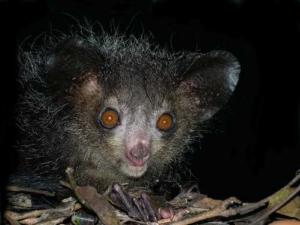 SKC Films Library SKC Films Library |
| SKC Films Library >> Science >> Zoology >> Mammals >> Order Primates |
| Aye-Aye Daubentia madagascariensis Description The aye-aye is perhaps the strangest-looking primate in the world. Its long, coarse coat is dark brown or black in color, with scattered white guard hairs. Facial features include large yellow-orange or sandy brown eye surrounded by dark markings, large triangular ears, a short snout, and a pink nose. The only primate with ever-growing incisors, the aye-aye was once thought to be a member of the rodent order. The aye-aye's long, bony fingers with sharp pointed claw are also unique, but it is the middle fingers on its front feet that truly set it apart from other primates. Much longer than the others, these fingers can move independently of the other digits. The world's largest nocturnal primate, the aye-aye averages 14-17 inches in length, not counting a tail that is at least as long as the body, and weighs 4-6 pounds. Males and females are similar in both size and coloration. Distribution and Habitat Widely distributed across the island of Madagascar, aye-ayes live in primary and secondary rainforest, deciduous forest, cultivated plantations, and occasionally dry scrub forest and mangrove forest, at altitudes of up to 6,150 feet. Like all other animals native to Madagascar, the aye-aye is seriously threatened by habitat loss. It is also hunted by natives, many of whom see them as crop pests. Some legends say that aye-ayes bring bad luck, which leads many natives to kill them on sight. Reproduction Aye-ayes can mate any time of the year. No courtship behavior has ever been documented, and both males and females may have multiple partners during any given breeding cycle. One baby aye-aye is born after a gestation period of 152-172 days. Infant aye-ayes are similar in color to adults, but have green eyes and floppy ears. Cared for exclusively by the mother, the young aye-ayes is able to leave the nest at 8 weeks and can eat solid food regularly at 20 weeks. The mother will not mate again until her offspring is independent, which takes about 2.5 years. Average lifespan in the wild is unknown, but captive aye-ayes have lived up to 23 years. Diet Aye-ayes feed on a variety of fruits, nuts, and seeds, as well as nectar and insects. Breadfruits,bananas, coconuts, and ramy nuts are among the favored plant foods, but bamboo, lychees, and mangoes are also consumed. Their tree-climbing abilities allow them to gather fruits and nuts from almost any part of the tree, while their long middle fingers allow them to pierce the outer skin of tougher fruits and scoop out the contents. Wood-boring insect larvae are found by tapping along a tree branch with the middle finger; whether the aye-aye is listening for a cavity created by the larvae or simply looking for a weak spot in the bark is unknown. Once a cavity is found, the aye-aye uses its strong incisors to chew a hole into the bark and uses its long middle finger to extract the larvae. Other Habits and Behaviors Aye-ayes spend almost all of their time in the upper canopy of trees, but will come to the ground on occasion. Well built for an arboreal lifestyle, aye-ayes often cling upside down on branches, can rest vertically or horizontally, and are able to make use of a wide range of locomotor methods including arboreal quadrupedalism, leaping, and head-first descent. Aye-ayes are nocturnal. Most of the daytime is spent sleeping in an oval-shaped nest located. During the night, aye-ayes spend their time alternately foraging, feeding, and grooming. Although they are generally solitary, aye-ayes may assemble in foraging parties of 2-3 individuals. Aye-ayes build their nests high in the trees and rarely sleep in the same one two nights in a row, which means that one territory can contain numerous nests. Individuals have their own ranges, which are scent marked and possibly marked by distinctive tooth impressions made by powerfully biting into tree bark. Male ranges are larger than female ranges, and each male range overlaps with at least one female range. Furthermore, male ranges overlap between 40 and 75 percent, and these shared spaces may be occupied by numerous individuals simultaneously. Female home ranges are from 30 to 40 hectares in area, while male home ranges are from 125 to 215 hectares. Scientific Classification phylum Chordata SOURCES |
| SKC Films Library >> Science >> Zoology >> Mammals >> Order Primates This page was last updated on June 15, 2017. |
